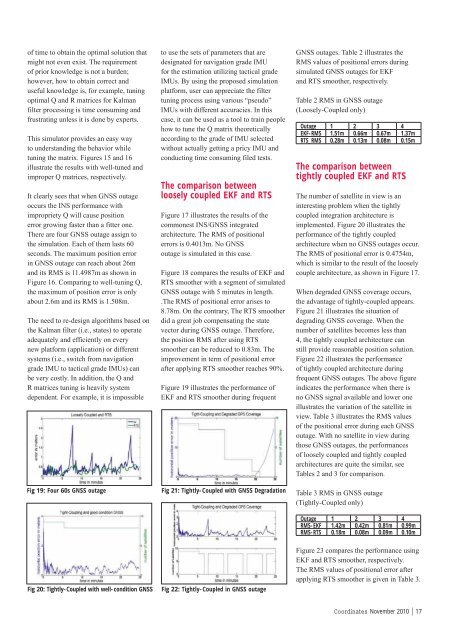Co-ordinates
Co-ordinates
Co-ordinates
You also want an ePaper? Increase the reach of your titles
YUMPU automatically turns print PDFs into web optimized ePapers that Google loves.
of time to obtain the optimal solution that<br />
might not even exist. The requirement<br />
of prior knowledge is not a burden;<br />
however, how to obtain correct and<br />
useful knowledge is, for example, tuning<br />
optimal Q and R matrices for Kalman<br />
filter processing is time consuming and<br />
frustrating unless it is done by experts.<br />
This simulator provides an easy way<br />
to understanding the behavior while<br />
tuning the matrix. Figures 15 and 16<br />
illustrate the results with well-tuned and<br />
improper Q matrices, respectively.<br />
It clearly sees that when GNSS outage<br />
occurs the INS performance with<br />
impropriety Q will cause position<br />
error growing faster than a fitter one.<br />
There are four GNSS outage assign to<br />
the simulation. Each of them lasts 60<br />
seconds. The maximum position error<br />
in GNSS outage can reach about 26m<br />
and its RMS is 11.4987m as shown in<br />
Figure 16. <strong>Co</strong>mparing to well-tuning Q,<br />
the maximum of position error is only<br />
about 2.6m and its RMS is 1.508m.<br />
The need to re-design algorithms based on<br />
the Kalman filter (i.e., states) to operate<br />
adequately and efficiently on every<br />
new platform (application) or different<br />
systems (i.e., switch from navigation<br />
grade IMU to tactical grade IMUs) can<br />
be very costly. In addition, the Q and<br />
R matrices tuning is heavily system<br />
dependent. For example, it is impossible<br />
to use the sets of parameters that are<br />
designated for navigation grade IMU<br />
for the estimation utilizing tactical grade<br />
IMUs. By using the proposed simulation<br />
platform, user can appreciate the filter<br />
tuning process using various “pseudo”<br />
IMUs with different accuracies. In this<br />
case, it can be used as a tool to train people<br />
how to tune the Q matrix theoretically<br />
according to the grade of IMU selected<br />
without actually getting a pricy IMU and<br />
conducting time consuming filed tests.<br />
The comparison between<br />
loosely coupled EKF and RTS<br />
Figure 17 illustrates the results of the<br />
commonest INS/GNSS integrated<br />
architecture. The RMS of positional<br />
errors is 0.4013m. No GNSS<br />
outage is simulated in this case.<br />
Figure 18 compares the results of EKF and<br />
RTS smoother with a segment of simulated<br />
GNSS outage with 5 minutes in length.<br />
.The RMS of positional error arises to<br />
8.78m. On the contrary, The RTS smoother<br />
did a great job compensating the state<br />
vector during GNSS outage. Therefore,<br />
the position RMS after using RTS<br />
smoother can be reduced to 0.83m. The<br />
improvement in term of positional error<br />
after applying RTS smoother reaches 90%.<br />
Figure 19 illustrates the performance of<br />
EKF and RTS smoother during frequent<br />
Fig 19: Four 60s GNSS outage Fig 21: Tightly-<strong>Co</strong>upled with GNSS Degradation<br />
Fig 20: Tightly-<strong>Co</strong>upled with well-condition GNSS Fig 22: Tightly-<strong>Co</strong>upled in GNSS outage<br />
GNSS outages. Table 2 illustrates the<br />
RMS values of positional errors during<br />
simulated GNSS outages for EKF<br />
and RTS smoother, respectively.<br />
Table 2 RMS in GNSS outage<br />
(Loosely-<strong>Co</strong>upled only)<br />
Outage 1 2 3 4<br />
EKF-RMS 1.51m 0.66m 0.67m 1.37m<br />
RTS_RMS 0.28m 0.13m 0.08m 0.15m<br />
The comparison between<br />
tightly coupled EKF and RTS<br />
The number of satellite in view is an<br />
interesting problem when the tightly<br />
coupled integration architecture is<br />
implemented. Figure 20 illustrates the<br />
performance of the tightly coupled<br />
architecture when no GNSS outages occur.<br />
The RMS of positional error is 0.4754m,<br />
which is similar to the result of the loosely<br />
couple architecture, as shown in Figure 17.<br />
When degraded GNSS coverage occurs,<br />
the advantage of tightly-coupled appears.<br />
Figure 21 illustrates the situation of<br />
degrading GNSS coverage. When the<br />
number of satellites becomes less than<br />
4, the tightly coupled architecture can<br />
still provide reasonable position solution.<br />
Figure 22 illustrates the performance<br />
of tightly coupled architecture during<br />
frequent GNSS outages. The above figure<br />
indicates the performance when there is<br />
no GNSS signal available and lower one<br />
illustrates the variation of the satellite in<br />
view. Table 3 illustrates the RMS values<br />
of the positional error during each GNSS<br />
outage. With no satellite in view during<br />
those GNSS outages, the performances<br />
of loosely coupled and tightly coupled<br />
architectures are quite the similar, see<br />
Tables 2 and 3 for comparison.<br />
Table 3 RMS in GNSS outage<br />
(Tightly-<strong>Co</strong>upled only)<br />
Outage 1 2 3 4<br />
RMS-EKF 1.42m 0.42m 0.81m 0.99m<br />
RMS-RTS 0.18m 0.08m 0.09m 0.10m<br />
Figure 23 compares the performance using<br />
EKF and RTS smoother, respectively.<br />
The RMS values of positional error after<br />
applying RTS smoother is given in Table 3.<br />
<strong>Co</strong><strong>ordinates</strong> November 2010 | 17
















